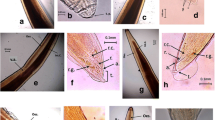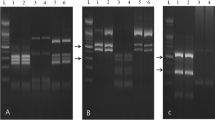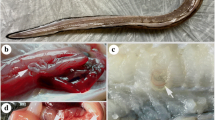Abstract
Walleye pollock (Gadus chalcogrammus) is one of the popular fish species in Korea and known to frequently harbor anisakid nematodes. Despite many papers regarding walleye pollock having been published, there is no information on the prevalence and distribution of anisakid nematodes from walleye pollock in Korean waters. We investigated 716 walleye pollock caught from Goseong, the East Sea of the Korean Peninsula during May 2015–December 2016. In total, 1,085 nematodes were collected and subsequently identified by PCR-RFLP analysis of internal transcribed spacer region of ribosomal DNA. The prevalence and mean intensity of anisakid nematodes was 63.6% (68/107) and 4.4 larvae/fish (297/68) in samples of 2015, and 21.5% (131/609) and 6.0 larvae/fish (788/131) in samples of 2016. The most abundantly isolated anisakid nematode was Anisakis simplex (Rudolphi, 1809) (73.5%, 798/1,085), followed by Contracaecum osculatum (Rudolphi, 1802) (3.1%, 34/1,085), Hysterothylacium aduncum (Rudolphi, 1802) (2.9%, 31/1,085), Anisakis pegreffii (Campana-Rouget and Biocca, 1955) (1.4%, 15/1,085), and a hybrid genotype (0.4%, 4/ 1,085). The mitochondrial DNA cox2 gene sequences of randomly selected A. simplex showed the highest similarity (99.5%–98.8%) with those from chub mackerel (Scomber japonicus) in Japan or from chum salmon (Oncorhynchus keta) in Korea. The mtDNA cox2 gene sequences of C. osculatum showed the highest similarity (99.0%) with those from bearded seals in Japan. All of these results give us clues to the geographical distribution, migration route and prey items of walleye pollock caught off Korea. Further extensive analyses will be necessary to get more information on the biology of Korean walleye pollock.
Similar content being viewed by others
References
Abattouy N, Valero A, Benajiba MH, Lozano J, Martín-Sánchez J (2011) Anisakis simplex s.l. parasitization in mackerel (Scomber japonicus) caught in the North of Morocco-revalence and analysis of risk factors. Int J Food Microbiol 150:136–139
Abe N, Ohya N, Yanagiguchi R (2005) Molecular characterization of Anisakis pegreffii larvae in Pacific cod in Japan. J Helminthol 79:303–306
Alonso-Gomez A, Moreno-Ancillo A, Lopez-Serrano MC, Suarezde-Parga JM, Daschner A, Caballero MT, Barranco P, Cabanas R (2004) Anisakis simplex only provokes allergic symptoms when the worm parasitizes the gastrointestinal tract. Parasitol Res 93:378–384
Audicana MT, Kennedy MW (2008) Anisakis simplex: from obscure infectious worm to inducer of immune hypersensitivity. Clin Microbiol Rev 21(2):360–378
Baird FJ, Gasser RB, Jabbar A, Lopata AL (2014) Foodborne anisakiasis and allergy. Mol Cell Probe 28(4):167–174
Bak TJ, Jeon CH, Kim JH (2014) Occurrence of anisakid nematode larvae in chub mackerel (Scomber japonicus) caught off Korea. Int J Food Microbiol 19:149–156
Bakkala R, Westrheim S, Mishima S, Zhang C, Brown E (1984) Distribution of Pacific cod (Gadus macrocephalus) in the North Pacific Ocean. Int North Pac Fish Comm 42:111–115
Busch MW, Kuhn T, Münster J, Klimpel S (2012) Marine crustaceans as potential hosts and vectors for metazoan parasites. In: Mehlhorn H (ed) Arthropods as vectors of emerging diseases. Parasitology research monographs, Vol 3, Springer-Verlag, Berlin, pp 329–360
Bush AO, Lafferty KD, Lotz JM, Shostak AW (1997) Parasitology meets ecology on its own terms: Margolis et al. revisited. J Parasitol 83:575–583
Catalano SR, Whittington ID, Donnellan SC, Gillanders BM (2014) Parasites as biological tags to assess host population structure: guidelines, recent genetic advances and comments on a holistic approach. Int J Parasitol 3:220–226
Chai JY, Murrell KD, Lymbery AJ (2005) Fish-borne parasitic zoonoses: status and issues. Int J Parasitol 35:1233–1254
Chen HY, Shih HH (2015) Occurrence and prevalence of fishborne Anisakis larvae in the spotted mackerel Scomber australasicus from Taiwanese waters. Acta Trop 145:61–67
Cheng TC (1976) The natural history of anisakiasis in animals. J Milk Food Technol 39:32–46
Cipriani P, Smaldone G, Acerra V, D’Angelo L, Anastasio A, Bellisario B, Palma G, Nascetti G, Mattiucci S (2015) Genetic identification and distribution of the parasitic larvae of Anisakis pegreffii and Anisakis simplex (s.s.) in European hake Merluccius merluccius from the Tyrrhenian Sea and Spanish Atlantic coast: implications for food safety. Int J Food Microbiol 198:1–8
D’Amelio S, Mathiopoulus KD, Santos CP, Pugachev ON, Webb SC, Picanco M, Paggi L (2000) Genetic markers in ribosomal DNA for the identifcation of members of the genus Anisakis (Nematoda: Ascaridoidea) defined by polymerase chain reactionbased restriction fragment length polymorphism. Int J Parasitol 30:223–226
Heath CB, Perrin WF (2008) California, Galapagos, and Japanese sea lions Z. californianus, Z. wollebaeki, and Z. japonicus. In: Perrin WF, Wursig B, Thewissen JGM (eds) Encyclopedia of marine mammals. Academic Press, Cambridge, pp 170–176
Holtcamp W (2010) Marine science: the tiniest catch. Nature 468:26–27
Jeon CH, Setyobudi E, Kim JH (2016) Occurrence and molecular identification of anisakid nematodes isolated from Pacific cod (Gadus macrocephalus) caught off Korea. Food control 69:100–107
Kang S, Kim S (2015) What caused the collapse of walleye pollock population in Korean waters. Int J Mar Aff Fish 1:43–58
Kim MJ, An HS, Choi KH (2010) Genetic characteristic of Pacific cod populations in Korea based on microsatellite. Fish Sci 76:595–603
Kim JH, Nam UH, Jeon CH (2016) Genetic identification of anisakid nematodes isolated from largehead hairtail (Trichiurus japonicus) in Korea. Fish Aquat Sci 19:1–8
Lee MW, Cheon DS, Choi CS (2009) Molecular genotyping of Anisakis species from Korean sea fish by polymerase chain reaction–restriction fragment length polymorphism (PCRRFLP). Food Control 20:623–626
Mattiucci S, Cimmaruta R, Cipriani P, Abaunza P, Bellisario B, Nascetti G (2015) Integrating Anisakis spp. parasites data and host genetic structure in the frame of a holistic approach for stock identification of selected Mediterranean Sea fish species. Parasitology 142:90–108
Mattiucci S, Nascetti G (2008) Advances and trends in molecular systemics of anisakid nematodes, with implication for their evolutionary ecology and host-parasite co-evolutionary processes. Adv Parasit 66:47–148
Mattiucci S, Paoletti M, Olivero-Verbel J, Baldiris R, Arroyo-Salgado B, Garbin L, Navone G, Nascetti G (2008) Contracaecum bioccai n. sp. From the brown pelican Pelecanus occidentalis (L.) in Colombia (Nematoda: Anisakidae): morphology, molecular evidence and its genetic relationship with congeners from fish-eating birds. Syst Parasitol 69:101–121
Mladineo I (2003) Anisakis simplex in Adriatic Sea. Period Biol 105:389–392
Mladineo I, Poljak V (2014) Ecology and genetic structure of zoonotic Anisakis spp. from Adriatic commercial fish species. Appl Environ Microb 80:1281–1290
Münster J, Klimpel S, Fock HO, MacKenzie K, Kuhn T (2015) Parasites as biological tags to track an ontogenetic shift in the feeding behaviour of Gadus morhua off West and East Greenland. Parasitol Res 114:2723–2733
Nadler SA, Hudspeth DSS (2000) Phylogeny of the Ascaridoidea (Nematode: Ascaridida) based on three genes and morphology: hypotheses of structural and sequence evolution. J Parasitol 86:380–393
Nascetti G, Cianchi R, Mattiucci S, D’Amelio S, Orecchia P, Paggi L, Brattey J, Berland B, Smith JW, Bullini L (1993) Three sibling species within Contracaecum osculatum (Nematoda, Ascaridida, Ascaridoidea) from the Atlantic Artic-Boreal region: reproductive isolation and host preferences. Int J Parasitol 23:105–120
NFRDI (2010) Ecology and fishing ground of fisheries resource in Korean waters. National Fisheries Research and Development Institute (NFRDI), SP-2010-FR-009, 405 p (in Korean)
Nishimura A, Yamada J (1988) Geographical differences in early growth of Walleye pollock Theragra chalcogramma, estimated by back-calculation of otolith daily growth increments. Mar Biol 97:459–465
Orecchia P, Mattiucci S, D’Amelio S, Paggi L, Plotz J, Cianchi R, Nascetti G, Arduino P, Bullini L (1994) Two new members in the Contracaecum osculatum complex (Nematoda, Ascaridoidea) from the Antartic. Int J Parasitol 24:367–377
Quiazon KMA, Yoshinaga T, Santos MD, Ogawa K (2009) Identification of larval Anisakis spp. (Nematoda: Anisakidae) in Alaska Pollock (Theragra chalcogramma) in northern Japan using morphological and molecular markers. J Parasitol 95:1227–1232
Quiazon KMA, Yoshinaga T, Ogawa K (2011) Distribution of Anisakis species larvae from fishes of the Japanese waters. Parasitol Int 60:223–226
Rello FJ, Adroher FJ, Benitez R, Valero A (2009) The fishing area as a possible indicator of the infection by anisakid in anchovies (Engraulis encrasicolus) from southwestern Europe. Int J Food Microbiol 129:277–281
Setyobudi E, Jeon CH, Lee CH, Seong KB, Kim JH (2011) Occurrence and identification of Anisakis spp. (Nematoda: Anisakidae) isolated from chum salmon (Oncorhynchus keta) in Korea. Parasitol Res 108:585–592
Smith JW (1984) The abundance of Anisakis simplex L3 in the body-cavity and flesh of marine teleosts. Int J Parasitol 14:491–495
Smith JW, Wooten R (1975) Experimental studies on the migration of Anisakis sp larvae (Nematoda: Ascaridida) into the flesh of herring, Clupea harengus L. Int J Parasitol 5:133–136
Sohn H, Park KJ, An YR, Choi SG, Kim ZG, Kim HW, An DH, Lee YR, Park TG (2012) Distribution of whales and dolphins in Korean waters based on a sighting survey from 2000 to 2010. Kor J Fish Aquat Sci 45:486–492 (in Korean)
Stromnes E, Andersen K (1998) Distribution of whale worm (Anisakis simplex, Nematoda, Ascaridoidea) L3 larvae in three species of marine fish; saithe (Pollachius virens L.), cod (Gadus morhua L.) and red fish (Sebastes marinus L.) from Norwegian waters. Parasitol Res 84:281–285
Tamura K, Peterson D, Peterson N, Stecher G, Nei M, Kumar S (2013) MEGA6: molecular evolutionary genetics analysis version 6.0. Mol Biol Evol 30:2731–2739
Thompson JD, Higgins DG, Gibson TJ (1994) CLUSTAL W: improving the sensitivity of progressive multiple sequence alignment through sequence weighting, positions-specific gap penalties and weight matrix choice. Nucleic Acids Res 22:4673–4680
Umehara A, Kawakami Y, Matsui T, Araki J, Uchida A (2006) Molecular identification of Anisakis simplex sensu stricto and Anisakis pegreffii (Nematoda: Anisakidae) from fish and cetacean in Japanese waters. Parasitol Int 55:267–271
Valero A, Martin-Sanchez J, Reyes-Muelas E, Adroher FJ (2000) Larval anisakids parasitizing the blue whitting, Micromesistius poutassou, from Motril Bay in the Mediterranean region of southern Spain. J Helminthol 74:361–364
Wasko AP, Martins C, Oliveira C, Foresti F (2003) Non-destructive genetic sampling in fish. An improved method for DNA extraction from fish fins and scales. Hereditas 138:161–165
Yamamura O, Honda S, Shida O, Hamatsu T (2002) Diets of walleye pollock Theragra chalcogramma in the Doto area, northern Japan: ontogenetic and seasonal variations. Mar Ecol-Prog Ser 238:187–198
Author information
Authors and Affiliations
Corresponding author
Rights and permissions
About this article
Cite this article
Nurhidayat, S.W., Nam, UH. & Kim, JH. Occurrence of Anisakid Nematodes in Walleye Pollock (Gadus chalcogrammus) Caught off the East Sea of Korea: Their Molecular Identification and Biological Implication. Ocean Sci. J. 53, 679–689 (2018). https://doi.org/10.1007/s12601-018-0047-6
Received:
Revised:
Accepted:
Published:
Issue Date:
DOI: https://doi.org/10.1007/s12601-018-0047-6




